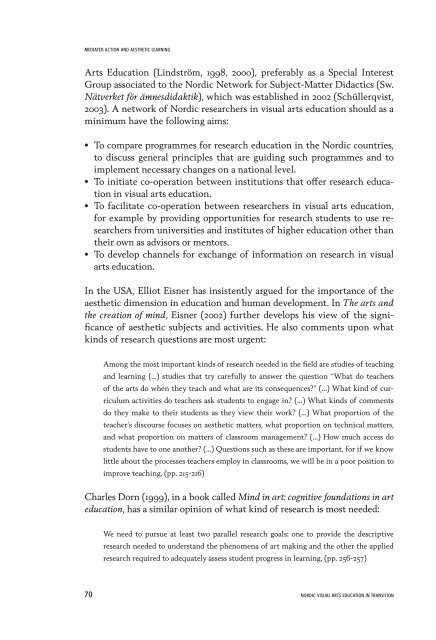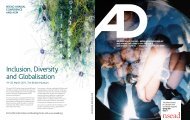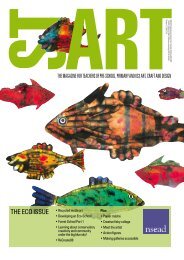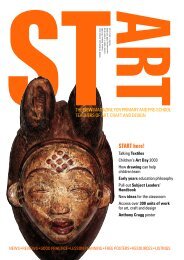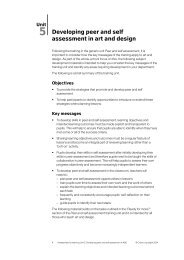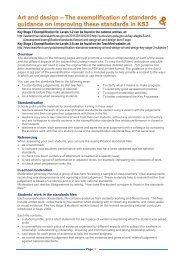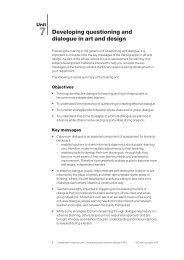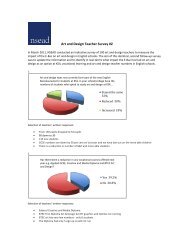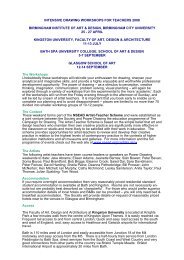Research in Visual Arts Education - Bilderlernen.at
Research in Visual Arts Education - Bilderlernen.at
Research in Visual Arts Education - Bilderlernen.at
You also want an ePaper? Increase the reach of your titles
YUMPU automatically turns print PDFs into web optimized ePapers that Google loves.
MEDIATED ACTION AND AESTHETIC LEARNING<strong>Arts</strong> <strong>Educ<strong>at</strong>ion</strong> (L<strong>in</strong>dström, 1998, 2000), preferably as a Special InterestGroup associ<strong>at</strong>ed to the Nordic Network for Subject-M<strong>at</strong>ter Didactics (Sw.Nätverket för ämnesdidaktik), which was established <strong>in</strong> 2002 (Schüllerqvist,2003). A network of Nordic researchers <strong>in</strong> visual arts educ<strong>at</strong>ion should as am<strong>in</strong>imum have the follow<strong>in</strong>g aims:• To compare programmes for research educ<strong>at</strong>ion <strong>in</strong> the Nordic countries,to discuss general pr<strong>in</strong>ciples th<strong>at</strong> are guid<strong>in</strong>g such programmes and toimplement necessary changes on a n<strong>at</strong>ional level.• To <strong>in</strong>iti<strong>at</strong>e co-oper<strong>at</strong>ion between <strong>in</strong>stitutions th<strong>at</strong> offer research educ<strong>at</strong>ion<strong>in</strong> visual arts educ<strong>at</strong>ion.• To facilit<strong>at</strong>e co-oper<strong>at</strong>ion between researchers <strong>in</strong> visual arts educ<strong>at</strong>ion,for example by provid<strong>in</strong>g opportunities for research students to use researchersfrom universities and <strong>in</strong>stitutes of higher educ<strong>at</strong>ion other thantheir own as advisors or mentors.• To develop channels for exchange of <strong>in</strong>form<strong>at</strong>ion on research <strong>in</strong> visualarts educ<strong>at</strong>ion.In the USA, Elliot Eisner has <strong>in</strong>sistently argued for the importance of theaesthetic dimension <strong>in</strong> educ<strong>at</strong>ion and human development. In The arts andthe cre<strong>at</strong>ion of m<strong>in</strong>d, Eisner (2002) further develops his view of the significanceof aesthetic subjects and activities. He also comments upon wh<strong>at</strong>k<strong>in</strong>ds of research questions are most urgent:Among the most important k<strong>in</strong>ds of research needed <strong>in</strong> the field are studies of teach<strong>in</strong>gand learn<strong>in</strong>g (…) studies th<strong>at</strong> try carefully to answer the question “Wh<strong>at</strong> do teachersof the arts do when they teach and wh<strong>at</strong> are its consequences?” (…) Wh<strong>at</strong> k<strong>in</strong>d of curriculumactivities do teachers ask students to engage <strong>in</strong>? (…) Wh<strong>at</strong> k<strong>in</strong>ds of commentsdo they make to their students as they view their work? (…) Wh<strong>at</strong> proportion of theteacher’s discourse focuses on aesthetic m<strong>at</strong>ters, wh<strong>at</strong> proportion on technical m<strong>at</strong>ters,and wh<strong>at</strong> proportion on m<strong>at</strong>ters of classroom management? (…) How much access dostudents have to one another? (…) Questions such as these are important, for if we knowlittle about the processes teachers employ <strong>in</strong> classrooms, we will be <strong>in</strong> a poor position toimprove teach<strong>in</strong>g. (pp. 215-216)Charles Dorn (1999), <strong>in</strong> a book called M<strong>in</strong>d <strong>in</strong> art: cognitive found<strong>at</strong>ions <strong>in</strong> arteduc<strong>at</strong>ion, has a similar op<strong>in</strong>ion of wh<strong>at</strong> k<strong>in</strong>d of research is most needed:We need to pursue <strong>at</strong> least two parallel research goals: one to provide the descriptiveresearch needed to understand the phenomena of art mak<strong>in</strong>g and the other the appliedresearch required to adequ<strong>at</strong>ely assess student progress <strong>in</strong> learn<strong>in</strong>g. (pp. 256-257)70 NORDIC VISUAL ARTS EDUCATION IN TRANSITION


